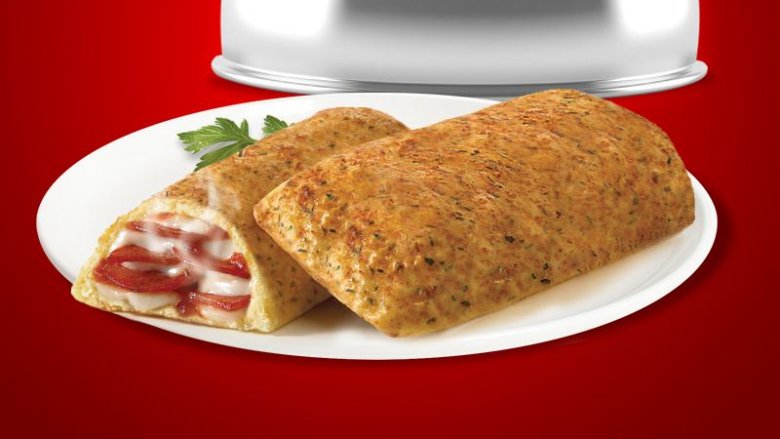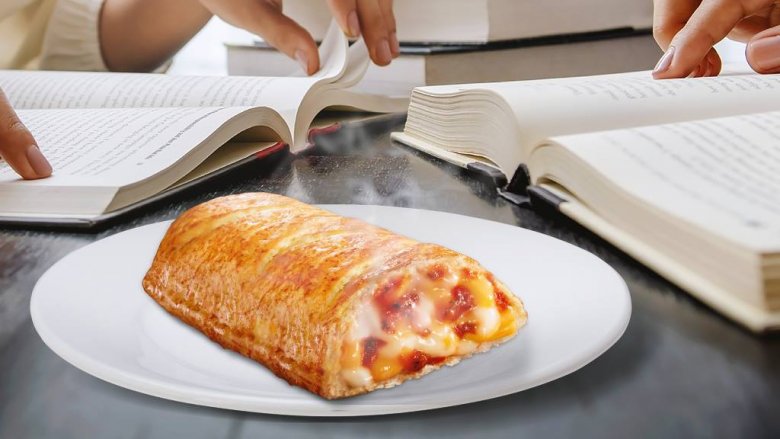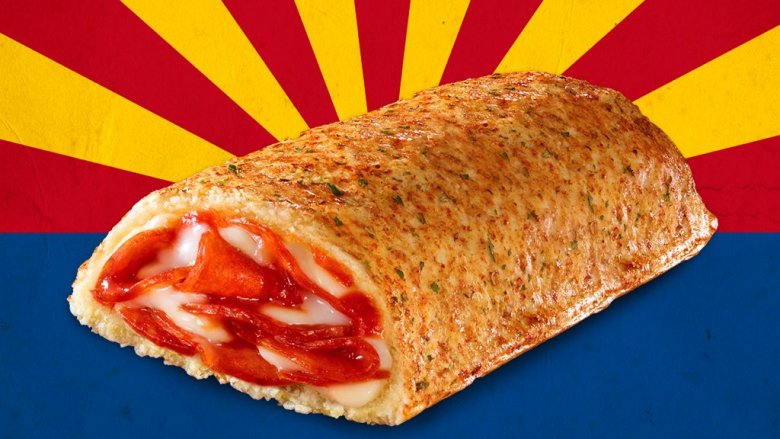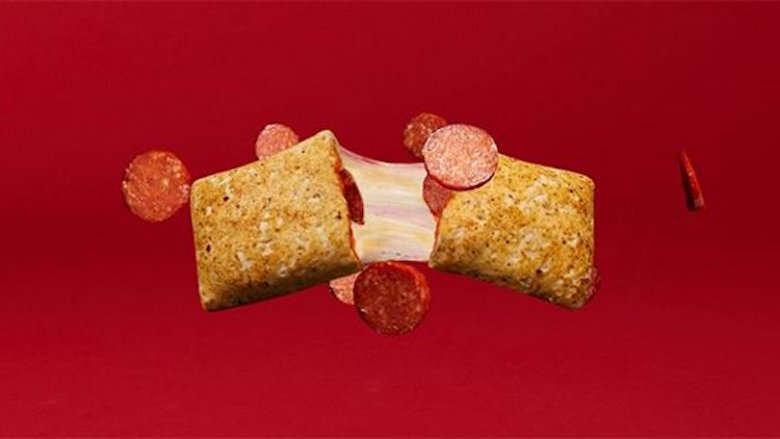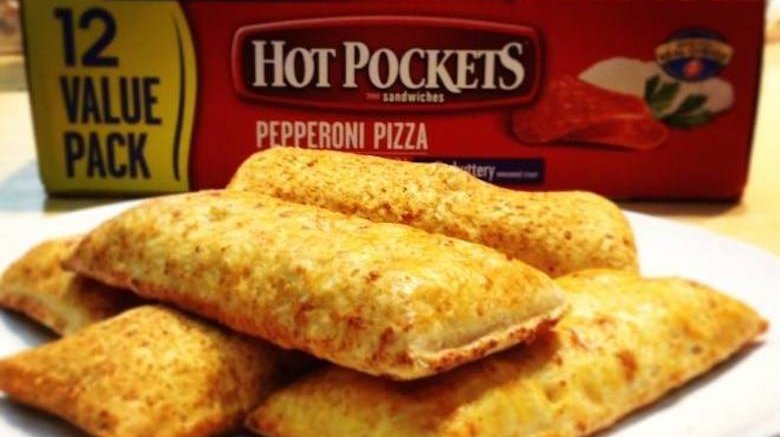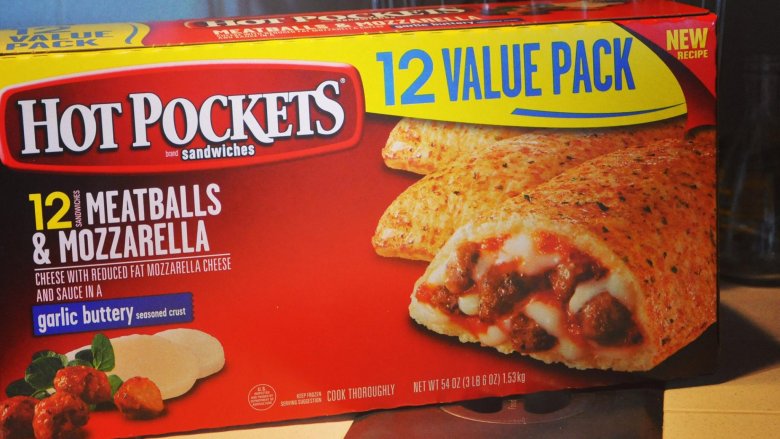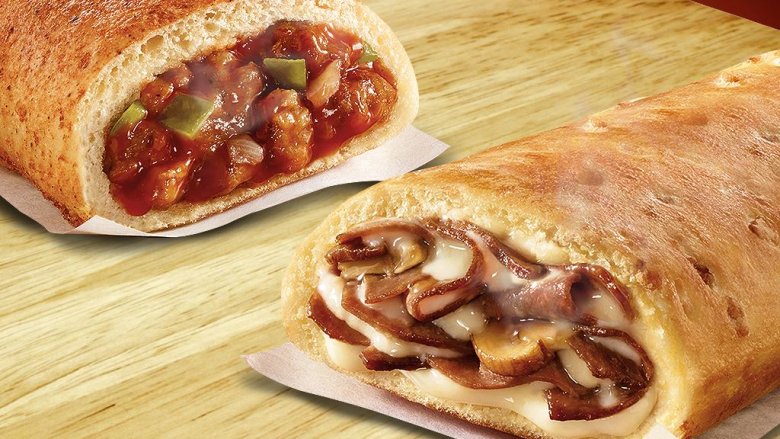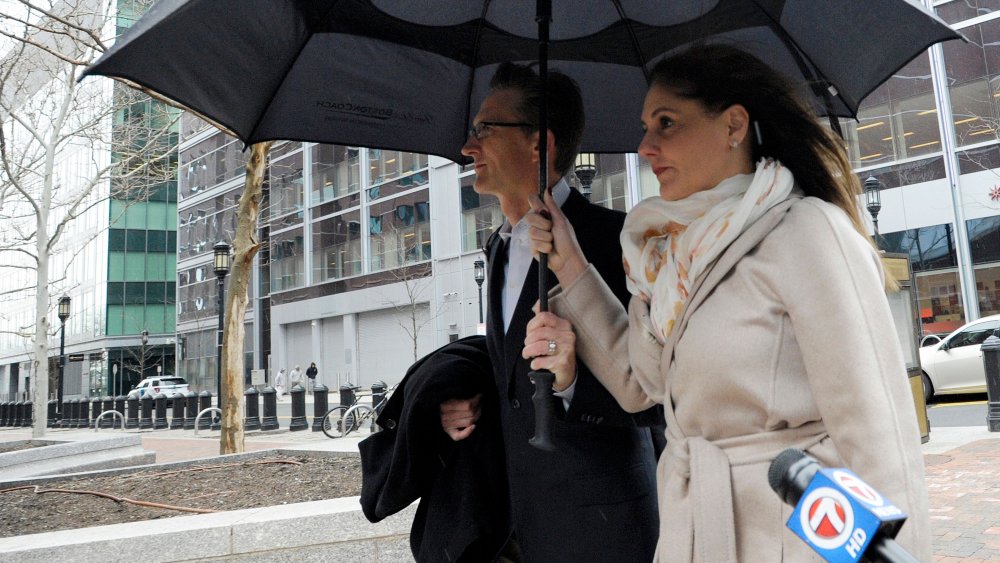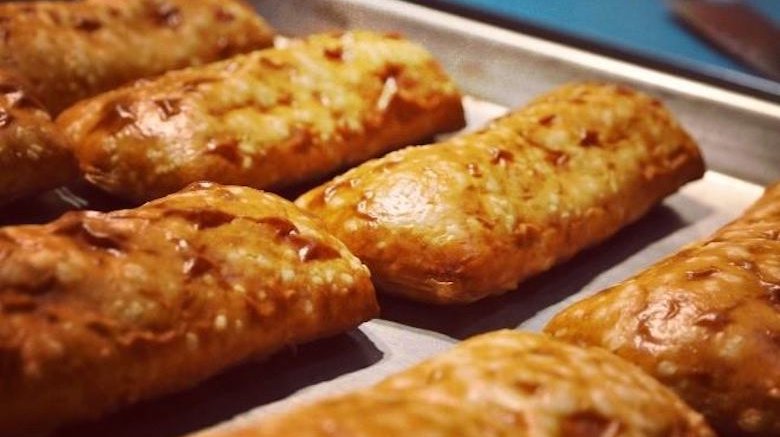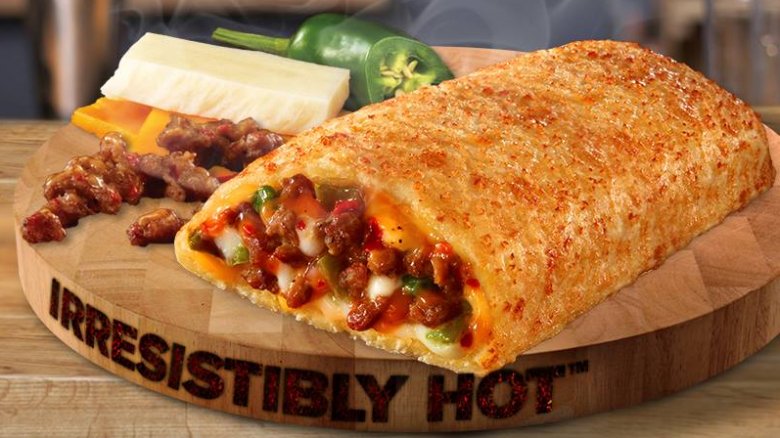The Untold Truth Of Hot Pockets
"Hot pockets!" Just two innocuous words on their own, but when sung... er, make that screamed together as an answer to "What are you gonna pick?" get into your head on repeat — the jingle (if you can call it that) is an instant earworm. Even though you haven't heard the commercial in 25 years, suddenly it sneaks in out of nowhere and you're emphatically insisting "Hot Pockets!" to nobody in particular as you wander your house. And just as suddenly, you're not only craving one, but also reminiscing about your youth.
Nostalgic as Hot Pockets(!) might make you, do you really know anything about your favorite childhood snack (aside from that damn jingle)? You do know, without a shadow of a doubt, that the first bite of the microwavable, molten-in-the-middle meal will burn at least three layers clean off the roof of your mouth. You also know that having this knowledge will not stop you from taking that too-soon bite every single time. But there's some other intel out there that might surprise you.
From its un-American roots, to the super-gross reason they were once recalled, and even a hack to heat them perfectly, here's the untold truth of Hot Pockets.
Hot Pockets were invented by Iranian immigrants
You might think that Hot Pockets, with their calzone-like appearance and unorthodox pizza fillings (hello, Cheddar Cheeseburger and Chicken Pot Pie), are some sort of Italian-American mashup, but you would be wrong. This oh-so-American staple, which has been gracing freezers for decades, was invented by Iranian immigrants.
According to Saveur, we wouldn't have Hot Pockets had it not been for Jewish Iranian brothers Paul and David Merage, who immigrated to the United States from Tehran. In 1977, the Merage brothers founded Chef America Inc. and set out to create a portable sandwich whose dough would actually retain its crispness after a few minutes in the microwave. Their creation, which debuted in 1980, was called the Tastywich, but it didn't last long with its original name. By 1983, after some recipe tweaking, the Tastywich had a new moniker and Hot Pockets officially hit the market.
Why don't more people know this iconic snack's true origins? For starters, Chef America was sold to Nestle in 2002, and most of us probably associate Hot Pockets with the company that owns other very American brands, like Gerber, Toll House, and Stouffer's. But aside from that, as sociologist Charles Hirschman explains, "A lot of the classical things we think of American were invented by immigrants. But they weren't trying to advertise their immigrant origins. They were looking for ways in which they could capture what they thought as 'American.'"
The quality of the ingredients in Hot Pockets might surprise you
To hear Nestle tell it, "the role of quality... is absolutely critical and central to everything [they] do." As the company says, "You can only make the best quality meals if you start with the best quality ingredients possible." But you're probably thinking, "Come on, we're talking about Hot Pockets here... how great can the quality of those ingredients really be?" The answer might surprise you.
According to Bloomberg (via Business Insider), in an effort to appeal to the millennial demographic who care about the quality of their food, the frozen snack underwent some recipe changes in 2013 as part of the "Better Taste. Better Quality" campaign. The company touted new and improved ingredients including premium meats (100 percent Angus beef, hickory ham, and white meat chicken), real cheese sourced from dairy farmers in Wisconsin, bread baked fresh daily, and from-scratch sauce — all fancier than you'd expect from a Hot Pocket, right?
Another Hot Pocket fact that may surprise you? Many of the products boast 10 grams (or more) of protein, which obviously means that instead of choking down a chalky protein shake, you can chow down on a Hot Pocket, with all its millennial-friendly ingredients, and feel perfectly fine about your choice.
The Hot Pockets recipe got revamped again in 2015
After the 2013 millennial grab, Hot Pockets again underwent some recipe tweaks — this time in an effort to gain a "healthier" reputation. Because let's be honest, even with 10 grams of protein each and 100 percent real cheese, it can still feel like you're making a slightly poor life decision when you eat three Hot Pockets for lunch.
The 2015 recipe revamp meant removing artificial flavors and cutting the sodium by 10 percent, changes that Nestle said would not affect that Hot Pocket taste we all know and love (in other words, we apparently like the taste of artificial flavors, but not the reality of them). The reformulation makes sense — in a time when consumers are forcing fast food companies to provide healthier options, brands selling frozen, pre-made fare simply need to follow suit. Perhaps not coincidentally, also in 2015, Forbes reported that 88 percent of consumers polled said they were willing to pay more for healthier food, and all demographics preferred foods with no artificial coloring or flavors. So really, Hot Pockets had no choice but to make their product appear healthier.
Hot Pockets drove a man to murder
Sometimes, a Hot Pocket craving strikes. It's usually around midnight, and there's usually a fair amount of alcohol involved, but suddenly the need for a Hot Pocket is undeniable. Finding no stock in the freezer, you make the responsible decision to send a teetotaling friend out to make the Hot Pockets run. But what if they don't return with the goods? Would it drive you to murder?
A lack of Hot Pockets is what made one man snap, reports WXIA-TV. Nathaniel Mathis had dispatched his sister and her boyfriend to procure some frozen snacks, but the store was sold out of his requested pepperoni Hot Pockets. They called Mathis to break the bad news —and also to fight about a shared EBT card — and by the time they returned home empty-handed, he was still livid. According to witness reports, Mathis approached the passenger side of his sister's car and shot her boyfriend eight times. He ran, but stopped to ask another witness to relay a message to his sister: "I just snapped. I love her and didn't mean for it to happen this way," Mathis said.
Ultimately, Mathis was arrested, charged with murder, and sentenced to life in prison plus 10 years, where he will presumably not be able to satisfy his original Hot Pockets craving.
There's a hack to heating Hot Pockets perfectly
If you haven't blistered the skin on the roof of your mouth and burned off all your tastebuds by biting into a Hot Pocket with its lava-like tomato sauce, have you even lived?
The thing is, to get the middle of the Hot Pocket hot enough, you've got to heat it for so long that the ends are basically full of boiling filling. We all know darn well how a Hot Pockets experience will end, but it turns out it doesn't have to be that way.
Lifehacker reports that one Redditor has solved all our Hot Pocket woes with this (now-deleted) heating hack — it just involves a little shaking. "Microwave the item for 75 percent of the suggested time. Take it out of the microwave, hold it at both ends, and shake it so the hot filling on each end mixes with the colder filling in the middle. Put it back in the microwave and cook for the remaining time. (Or just cook it in the oven for the remaining time to add a little extra crispiness.)" Problem solved. You'll probably still obliterate the inside of your mouth, but maybe they'll be first degree burns instead of third.
Hot Pockets helped an actor gain 40 pounds fast
This probably isn't the kind of press Nestle ideally wants for Hot Pockets, but if it's really true that any PR is good PR, having a celebrity mention your product while promoting a movie isn't such a bad thing.
For the 2015 film The End of the Tour, Jason Segel played acclaimed writer David Foster Wallace, who happened to have a few pounds on the actor. So, in an effort to pack a whopping 40 pounds onto his frame — and fast — Segel turned to "the Hot Pocket diet." (No, as much as we wish it was, it's not a real thing.)
People reports that the actor, speaking on Live with Kelly and Michael, explained his weight gain method, saying, "By the end, I was running out of time. I had about two weeks left, so I put myself on a Hot Pocket diet, which was two Hot Pockets every three hours. It was horrible. I was eating like 12 Hot Pockets a day at that point. I was so sick of them." But hey, they did their job, and after taking some time away, Segel is ready for more. "I swore that I'd never eat another Hot Pocket, but if you put a Hot Pocket in front of me right now, I'd eat it," he said. Honestly Jason, same.
But what about a Hot Pocket diet to lose weight?
Okay, so we know that a steady diet of 12 Hot Pockets a day can assist in your quest to gain 40 pounds, but what if you went on a more reasonable Hot Pocket diet? That's what one So Yummy writer did, and the results were a bit surprising.
Karen Belz decided to try a week-long Hot Pocket diet, meaning she would eat nothing but Hot Pockets for breakfast, lunch, dinner, and any snack in-between. Not too far into day one, she realized that she was dragging between meals (hello, carb-centric energy crash), and by day two had a bit of a stomachache. By week's end, her stomach had acclimated, though Belz reported feeling another big energy dip — probably not a great long-term plan. But here's the kicker... after a seven-day Hot Pocket extravaganza, she had actually lost two pounds. Belz attributes this to knowing exactly how many calories she was eating, much like diet plans with prepackaged foods.
Moral of the story? On a Hot Pockets-only diet, you can either lose a few pounds, or gain 40. But somewhere in the middle is a happy medium where you actually get to eat other non-Hot Pockets fare, the thing Belz said she missed most.
Hot Pockets were recalled for a gross reason
Food recalls happen all the time — sometimes it's for an odd reason, like when Kraft recalled their American cheese because consumers weren't able to successfully peel the plastic off, thus creating a choking hazard (which, let's be honest, sounds like more of an operator error); other times it's due to common bacteria like E. coli, which caused the great romaine lettuce recall of 2018. These are pretty standard reasons, and we typically toss said recalled items and go on with our day.
But something that's recalled because it's "unfit for human food"? That'll make you think twice about a product, and that's exactly why Hot Pockets were recalled in 2014, according to CNBC. The issue stemmed from 8.7 million pounds of Rancho Feeding Corp's beef, which was used in some varieties of Hot Pockets, and was recalled by the FDA because the company processed — steel yourself for this one — "diseased and unsound animals." Thankfully, the recall only affected the Philly Steak flavors, which meant we could all go on eating Pepperoni Pizza Hot Pockets to our heart's content. But will you ever look at Croissant Crust Philly Steak and Cheese the same way again?
The Hot Pockets heiress was caught up in the college admission cheating scandal
When news broke that well-to-do parents had been caught paying for their children to be admitted to some of the top schools in the country, people were understandably outraged. Names like Lori Loughlin and Felicity Huffman were most commonly talked about, but in February 2020, another sentence was announced: Michelle Janavs, heiress to the Hot Pockets fortune and former company exec, was sentenced to five months in jail for paying a total of $300,000 to get one of her daughters into the University of Southern California via faked a fake position on the volleyball team, as well as to cheat on ACT tests for her two daughters.
According to CNN, Janavs had previously pleaded guilty to all charges, and included in the sentence was a $250,000 fine, and two years supervised release after serving her time.
Her actions, reported The New York Times, had a devastating impact on her children — both daughters (who are were still in high school and weren't charged) were banned from campus — classes and events — at the Sage Hill School they had been attending; the elder daughter enrolled in community college, while the younger enrolled in a public high school to finish her last year.
Janavs's attorney, John Littrell, had this to say following the sentence: "But this crime does not define who she is. Michelle's gonna be defined by what she's done the rest of her life, and she had dedicated decades of her life to helping exactly the types of kids who were harmed in this case."
There's a name for that magical Hot Pockets sleeve
No matter how many times you've nuked a Hot Pocket, it still feels like something magical happened when you pull one out the microwave, slide it out of its sleeve, and discover that its crust has actually crisped up. How the heck does it do that?
That magical crisping sleeve actually has a name: a susceptor. According to HowStuffWorks, it's not really magic that makes this seemingly simple cardboard and metal-laminated invention work, it's actually a matter of converted energy. They explain that the susceptor "converts microwave energy to radiant heat and allows the food to brown." As luck would have it, the first susceptor was patented in 1981, just in time for the Merage brothers to utilize it in their quest for a sandwich whose dough would retain its crispy texture when microwaved.
For the perfect Hot Pocket heating experience, Nestle recommends using a paper plate under the crisping sleeve, presumably so that a ceramic plate doesn't absorb any of the energy the Hot Pocket needs to be its best.
There's a scientific reason every bite of Hot Pockets is a different temperature
Even with the amazing incredible crisping sleeve (or susceptor, if you're feeling fancy), and even with the internet's best frozen food microwave hacks, it seems like Hot Pockets never heat to the same temperature throughout (there's even a meme about it, so it must be true). It's either the right temperature on the outside, but the middle is still icy, or it's approximately 1,000 degrees on the outside and the middle is just hot enough, or — and this one's the most fun — the whole shooting match is approximately 2,000 degrees, with that standard-issue molten middle. Why do you have to be like this, Hot Pockets?
ScienceBlogs has an explanation: Microwaves don't heat up frozen water molecules (AKA ice) as efficiently as regular ol' unfrozen water molecules. So as each layer of icy molecules on the surface of the Hot Pocket crust melts into water, it's free to heat up. Then it's onto the next layer. This continues, with each previous already-heated layer getting hotter and hotter and hotter, and explains why you can bite into a still-frozen-in-the-middle Hot Pocket while simultaneously burning off your tongue. Thanks, science!
Jim Gaffigan famously riffed on Hot Pockets
If there's one famous name most associated with Hot Pockets, it's probably comedian Jim Gaffigan. And, much to Nestle's chagrin (we assume), it's not because of how often he professes his love for them — quite the opposite, in fact.
In his 2005 comedy special, Beyond the Pale, Gaffigan took the freezer aisle favorite to task, saying that he was moving slow that night because he'd had a Hot Pocket for dinner, deeming it white trash food not unlike a "Pop-Tart full of nasty meat." But good news, he said, "There is the vegetarian Hot Pocket for those of us that don't want to eat meat, but still would like diarrhea." He did admit to buying the product (score one for Hot Pockets), but ultimately concluded he was never glad he ate one. Gaffigan finished things up by touting the recent introduction of the breakfast Hot Pocket, saying, "I can't think of a better way to start the day... good morning!... you're about to call in sick."
All in all, not the best review of the product, but people sure do connect Hot Pockets with Jim Gaffigan, so that's got to be worth something for the brand, right?
